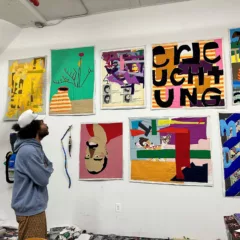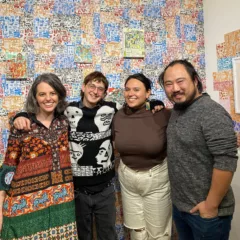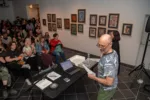Sara McCorriston and Jason Chen tumbled into the gallery business right out of art school. Fueled by youthful energy and enthusiasm for colorful accessible art, and steered by Chen and McCorriston’s innate business acumen, now, almost 6 years later, Paradigm Gallery+Studio is so successful that the co-founders have quit their day jobs and can oftentimes pay themselves a monthly commission.
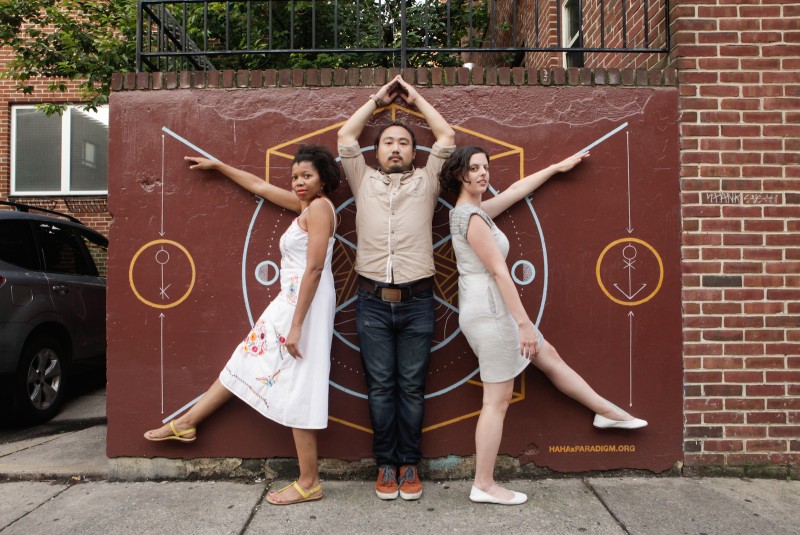
I met Sara and Jason and their collaborator Ginger Rudolph, of HaHa Magazine, at the gallery last summer, and we talked about business plans, online sales and social media. And of course we talked about making art accessible, because, for Sara, from New Hope, with a degree in theater design and technology, and Jason, from Guangzhou, China (moved here when he was 13), with a degree in animation and film, making art accessible is the actual point of it all. That and having some fun.
The beginning
The two University of the Arts schoolmates and friends (they’re not a couple) began collaborating on projects while they were in school. After graduation, they decided to find a shared studio space to continue their collaborations, and set up shop in a storefront at 2020 South St. And in 2010, they asked themselves, “Why not start a gallery?” They already had a good space and a friend they wanted to show, so they just went ahead and did it.
The inaugural show in Feb., 2010, featured works by Yis Goodwin and Nos Go (a schoolmate of theirs at UArts). All the works sold out at the opening. And then they became an LLC.
McCorriston, a bright, bouncy extrovert with a big smile, is the business person, manager of the books, director of social media and PR. Chen, intense and reserved, is the technical side. He does the website, hangs the shows, photographs the art. Together they make decisions that steer the gallery.
Taste
Their taste in art is wide ranging, but could be characterized as mid-sized well-crafted art with a street/music/youth aesthetic. They show street art indoors (Joe Boruchow, Ishknits and others) and studio artists (e.g, Kelly Kozma, Amze Emmons, Lauren Rinaldi).
The gallery space they’re in on 4th St. south of Bainbridge has a big front space, a narrow isthmus in the middle and a small alcove-like back space. They make smart use of all 3 segments, using them as differentiated spaces with larger works in the front and smaller in the isthmus and rear space.
Internet and social media
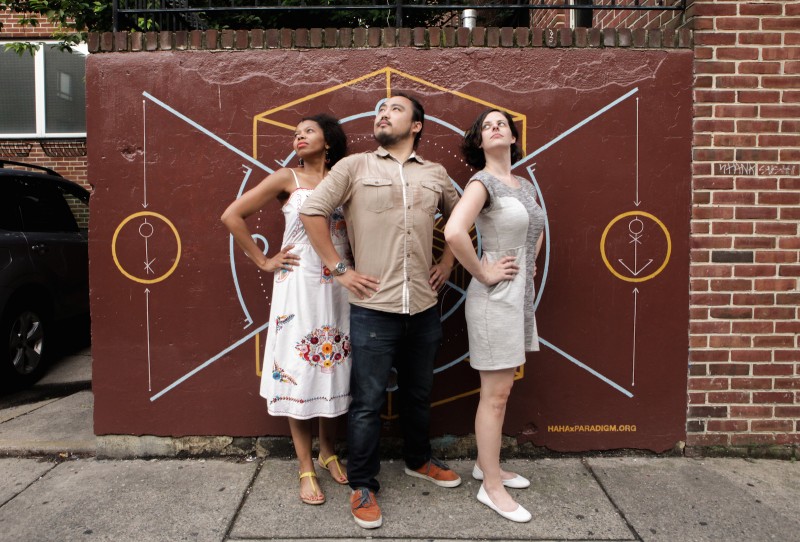
As Internet natives they are naturally tech savvy. Before they had a website they had a Facebook group page — that was before FB business pages existed. They have a website now, and it includes an online store. Their inventory is online, as much as 600 pieces sometimes, depending on what’s showing and how many works in the show. For example, with Kelly Kozma’s recent show, there were 80 works in the show, so 80 works added to inventory. Explaining the vast inventory, Sara says they have many collectors who can’t make the openings and who want to buy the art so this is the way to make that happen. “Caitlin McCormack (one of their artists) has collectors from all over the world…in Amsterdam. They’ve never been here. They come to the gallery from the website.” Lauren Rinaldi’s cheeky sketches go for under $50 – they are big sellers.
The gallery is active on social media and finds it good for creating community, picking the people’s favorite images from shows, and for sales. Images that get the most likes on social media will likely become the postcard and advertising image. Sara manages social media. She’s almost always on her phone. “It’s mind numbing. I’m typically doing 2 things at once.” They have 7,570 followers on Instagram and make sales on Instagram, she said.
Jason and Sara have different ideas about social media. “It’s a tool, how can you not use it?” says Sara. “It’s great Sara likes it,” says Jason, who pretty much leaves social media alone.
Philadelphia and passion projects
They like it here and don’t think of moving the gallery to, say, New York, or elsewhere. Philadelphia has the accessible art they want and it’s affordable, allowing them to do what Sara calls their “passion projects.”
Like HaHaxParadigm, a community project they have just branded that has been going on for a couple years now under a slightly different name. HaHa Magazine is Ginger Rudolph and colleagues, writing about arts and culture around the world with heavy picture rotation and an emphasis on street art. HaHaxParadigm is Ginger, Jason and Sara doing community projects in Philadelphia like commissioning artists to paint ugly electrical boxes on South Street, which happened this summer. Or commissioning other street or gallery artists to put their art out in the city and organizing a “scavenger hunt” for the art, because it’s fun, says Sara, and because “art needs to be accessible…It’s why we do free classes.”
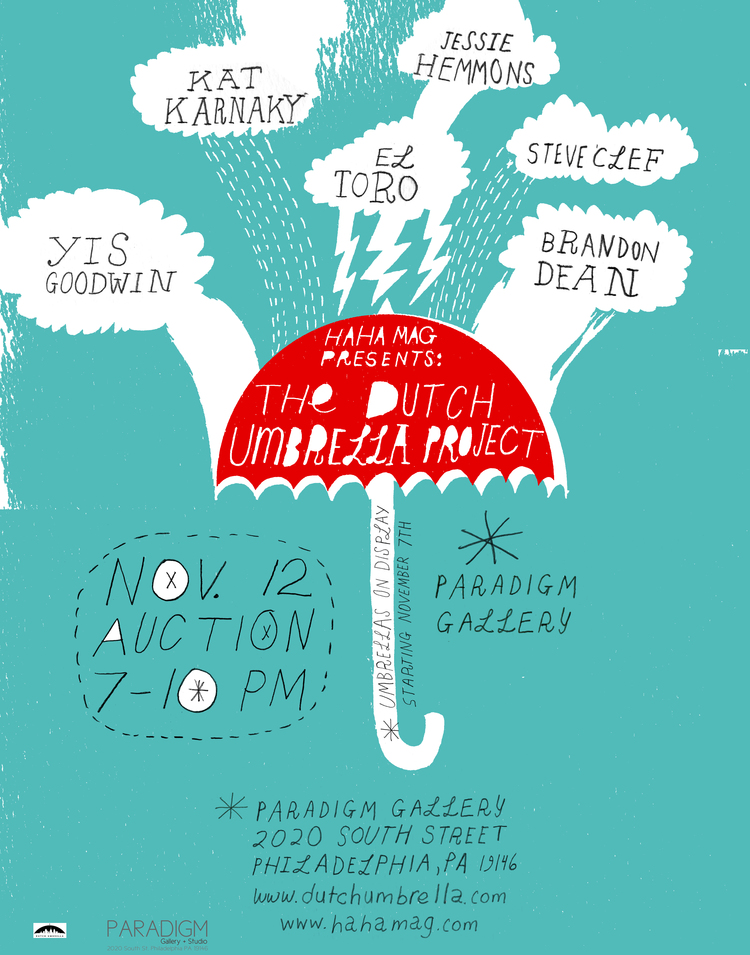
Ginger: “We met in 2011 or 2012. I was doing a charity event and needed space.” The event was painted umbrellas — an umbrella share.” They commissioned 5 gallery artists to hand paint umbrellas, put them on view and auctioned them off for charity. “I just wanted to work with these guys again.”
Sara: “We wanted more interactive public art. Bringing what’s in the galleries to the street.”
Art Fairs too
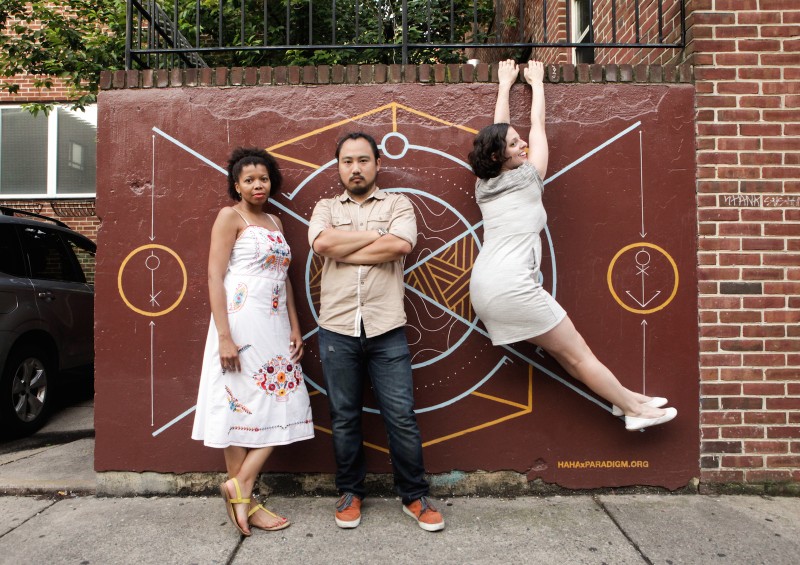
That said, Paradigm participates in the international art fairs — two years now at Scope Miami and this year they will be in Miami as well, showing and selling works by gallery artists. “Gallery Joe, Pentimenti, they do the art fairs. I’m proud to see Phila put it together. We’re about ‘buy local’ but we know it’s not enough to survive,” Sara says.
“But I can’t imagine only doing art fairs. I like it when Kelly Kozma comes in and paints on the walls (as part of her summer show, Kozma painted dotted lines all over the gallery walls to demarcate different series of works in the 80-work show).” This would be hard to do at the art fairs.
How the business happens
Half way through our interview, a couple comes in to pay for their art and take it with them. It’s typical of the way thing move at the gallery, fluidly, commerce and art coming together no big deal.
Sara does the bookkeeping on Sun-Mon. They have a bookkeeper and use xero (cloud-based services.) They need to integrate their point of sales system, Shopify and xero. “Shopify has point of sales but doesn’t do consignment.” Sara says, which, of course, is how artists work with galleries — the work is on consignment. Paradigm had to go elsewhere for their point of sale. As alumni of UArts, they qualify to apply for Corzo Center funding and that is how they got a grant for the POS, which they now have.
The world of business in art is changing. Sara and Jason remember that at their first show they didn’t take credit cards and Square wasn’t around. It was cash and checks. “We were running off receivable books,” Sara says.
Nowadays they have openings with sales in the gallery and sales online simultaneously. “People expect real time inventory (online). Lots of galleries don’t put all inventory online. We have every single piece of inventory online. As many as 500-600 at times, 300-400 currently,” Sara says.
In November Sara and Jason will show their own work at Paradigm

This is scary for Sara. “I haven’t shown here since 2011. But I need to show my work and find out. It may be I am a curator. What’s my art? The gallery is my studio. Is having an exhibit fulfilling?”
Sara: “I really want Jason to make work! If Jason was an artist and applied to Paradigm, he’d be accepted and I wouldn’t. (Laughs) We will encourage old theater friends to do things in the gallery. We have a history of performance. Theater and visual arts are very different, and there’s not enough crossover….I love that Bridgette (Mayer) has a show for Ballet X.
Kristen Seikaly, Jason’s girlfriend, is opera singer, and will perform in early November.
Future
“We’ve grown with our community,” says Sara, whose role as spokesman for the gallery has her now participating in art community events outside the gallery. She is on the Print Center Centennial Committee, where she’s had an impact on some of the programming for the Centennial Celebrations. “I feel that as someone on the younger end, my ideas are listened to,” she says.
“We are exactly or further than we thought we’d be in 5 years,” she says. “We thought we’d be closed. But we have so much further to go…You never know which projects are going to succeed. The model works because of the 2 people involved. One day we have to hand over the reins to others. We like the artists to take over so we have inventing things,” she says.
They tell me an anecdote that they still are pinching themselves about. It pours out like a Tweet, urgent.
“We were hanging work for Swizz Beatz (Kasim Dean, married to Alicia Keyes). It’s Alicia Keyes’ house. Swizz Beatz collects art. It’s the Dean collection. He came to our booth at Scope Miami. He buys what he loves — Drew Leshko’s building model.”



